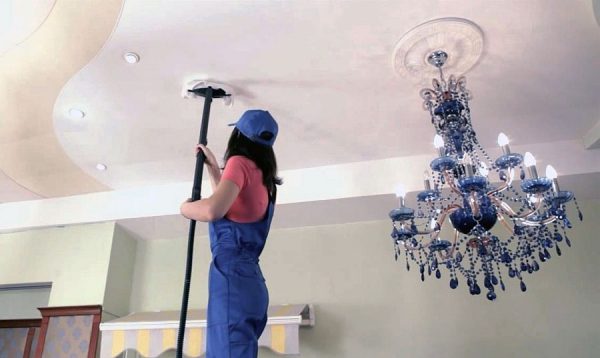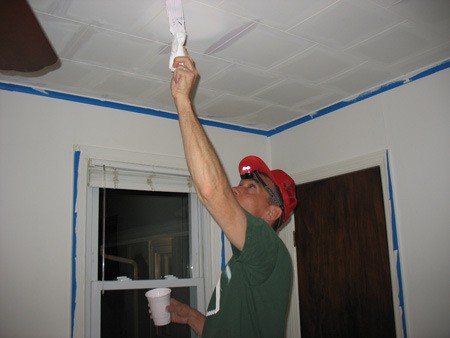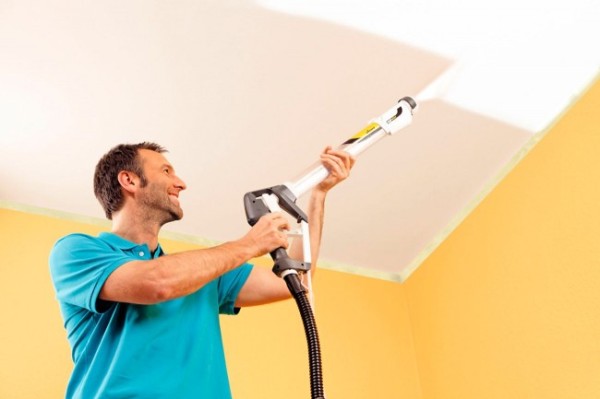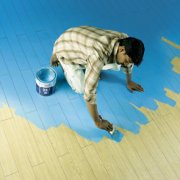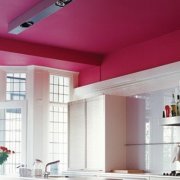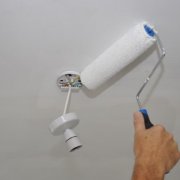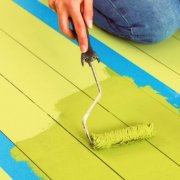How is water-based paint painting the ceiling
If you need to inexpensively and efficiently perform repair ceiling works, then painting the ceilings with water-based paint with your own hands is an excellent option for an inexpensive repair method. This paint has a unique composition. Thanks to him, it is highly resistant to any moisture and durable.
Today we will tell you how to paint the ceiling with water-based paint. A video will be presented in this article and photos that will help to miss nothing.
The content of the article
The choice and rules for applying a water emulsion
Water-based paint presented in the form of a liquid suspension, which contains dissolved polymer particles and pigment substances.
Attention: The peculiarity of this composition is the rapid evaporation of the liquid when applied to the surface, so that the polymers create a coating that has high resistance to moisture.
In addition, the aqueous emulsion composition is environmentally friendly and hypoallergenic, respectively, it does not cause allergies and other harmful effects on the human body as a whole.
Some people wonder if it is possible to paint the ceiling tile with water-based paint, because sometimes it is easier to paint than to remove. Of course you can paint.
You just have to putty the plane (see How to putty the ceiling with your own hands correctly) so that it is smooth and even. True, you may need a second ceiling painting with water-based paint. After all, it will be necessary to block the previous coating and make the plane uniform in color.
The main criteria for choosing a water-based composition for the ceiling
If you chose a water-based paint among the many modern means for repairing the ceiling, you will have to solve a difficult task, since from the variety of compositions presented today, you need to choose a quality product that will suit you both in quality and in cost.
Painting the ceiling with water-based paint the cost of the work will not be small, so it is better to do everything yourself. First of all, you need to choose the right dye.
Attention: How much it costs to paint the ceiling with water-based paint will depend on the cost of the dye and the amount of work performed. Usually painting takes the same amount as the materials.
Modern manufacturers today offer paints with the addition of a variety of substances to the bottom.
Here are the main ones:
- Polyvinyl acetate - These are the most inexpensive coatings from the whole group. They have a significant drawback - you can use such compounds only in dry places. The ceiling painted with such a paint is strictly forbidden to wash.
- Emulsion suspensions with the inclusion of latex - This is the most expensive option. One of the main advantages of such paints is the ability to wash surfaces coated with this paint with the addition of detergents. Also, the surface coated with latex emulsion has a smooth and very attractive appearance.
- Water-based suspensions with acrylic - Perhaps the most popular and desired for today.They can cover surfaces in any place, an indisputable advantage is the increased resistance to wiping when leaving.
- Compositions in which "water glass" or silicate is added - are widely used for coating surfaces having a stone or concrete base, as well as plastered walls.
- Silicone emulsion paints - such compositions are very convenient, as they can be applied directly to the plastered surface without a primer. Another advantage and advantage over other compounds is their vapor permeability, that is, they are perfect for ceiling coatings in the kitchen and in the bathroom. In addition, these paints are able to protect surfaces from a variety of harmful fungi and microorganisms.
So, to select the same paint (see The better to paint the ceiling: choose a paint), which will have an affordable price, worthy of the characteristics and after using it gave a beautiful result is not easy enough. Yes, and one name on a jar of product is not enough to understand the main differences between one paint from another. That is why it is very important to carefully consider the labels on the labels.
Label is an important source of information.
On the label, which is glued on a bank with an emulsion composition, the manufacturer indicates important data on the product:
- For what purposes and work is the suspension intended;
- Emulsion consumption per 1 m² - Having this information, you can accurately calculate the required amount of solution for work;
- Paint Shelter, that is, the ability of a given composition to cover a dark canvas with white even color that looks like a solid field;
- The indicator of resistance to wiping during washing and wet cleaning.
Attention: Also on the jar there is a small print. It is there that, as a rule, all the main characteristics of the emulsion are indicated.
Let's look at how to understand the small print in the annotation:
- Increased resistance to wiping (dry) - this instruction indicates that the surface treated with this suspension is not allowed to be wet cleaned, but only allowed to be dried with a dry material or an ordinary household vacuum cleaner.
- Use in dry rooms, where operation with reduced load is carried out - this line excludes the possibility of using this suspension in kitchen rooms, where fumes are plentiful during cooking, as well as in bathrooms due to high humidity.
- Leave-in paint, with high abrasion resistance - allows you to wash the ceiling covered with this composition, without the use of household detergents.
- High dirt-repellent indicators, resistance to wiping at the time of intensive cleaning - this type of emulsion is the best. Surfaces with such a composition are allowed to be washed with the addition of detergents.
Other characteristics of all water based paints are their dullness and glossiness. All compositions are divided into glossy and semi-gloss and matte and semi-gloss.
- Matte suspensions give the room a greater sense of height, as well as mask and hide visible defects more strongly. Their disadvantage is the difficulty in washing. Surfaces treated with glossy compounds are much easier to wash, but even the smallest flaws and cracks are clearly visible on them. Therefore, the most optimal and best option would be a semi-gloss or semi-gloss composition.
- When buying a water emulsion, it is important to pay attention to the warehouse where the cans with the composition were stored. Warehouses must necessarily be heated, since when a suspension freezes in it, a structure that cannot be restored after thawing is destroyed. That is why paint that has been frozen loses useful qualities.
It is most reliable to use an emulsion for coating surfaces, which is suitable for painting ceiling spaces.
Preparatory stages of the painting
All preparatory manipulations before applying a new layer of water emulsion on the ceiling should take place in several stages. The final result of all repair work will depend on the correctness of their conduct.
- Stage one - get rid of the old emulsion coating (see How to remove water-based paint from the ceiling quickly) This process is quite complicated and time-consuming, since the old layer of emulsion composition is almost impossible to completely remove from the ceiling, as it is insoluble in water. That is why all the manipulations at this stage are reduced to getting rid of exfoliated areas of paint with a conventional spatula.
- To facilitate this procedure, they often use a simple but effective technique. A surface with old paint must be moistened with plenty of plain water. To do this, you can use either a soft foam roller or a water spray. This is done twice - every 20 minutes. The applied liquid should absorb into the coating as best as possible.
- After a draft is created by opening all the doors and windows in the room. Thanks to this, the swollen layer of the old coating forms air pockets that can be easily removed with spatulas. This should be done as quickly as possible so that the surface does not have time to dry again.
Caution: After completing all paint removal work, all areas should be treated with five percent copper sulfate in solution to get rid of smudges and rust.
If there are difficult to remove impurities on the ceiling, one of the following substances can be used:
- 2% or 3% hydrochloric acid. You need to work with her in protective equipment, try to ensure that she does not appear on the skin. She is rubbed with stains.
- In 1 part, drying oils bred two dozen parts of lime.
- Lime is diluted in water to a thick state and about 50 milliliters of denatured alcohol are added.
The last two compositions must be applied to the stains for about 15 minutes. Such a procedure is repeated until the pollution disappears completely, on average a couple of procedures will be enough.
The next step is the alignment of the ceiling.
- After all the cleaning work, it’s time to level the ceiling. For these purposes, it is better to use a thin layer of putty. This material is good in that it has excellent adhesion properties, ductility and when applied lies evenly, which can then be easily sanded with sandpaper. The application of such putty is carried out with a spatula.
- Quite often, they use a special whitewash putty with an oil-glue base for leveling. It lays well and is uniformly easily applied to the coating with a familiar roller. Before its use in the ceiling, all the cracks are closed by filling them with a finished composition.
- Priming work - a ground surface with the same paint, which is applied with a thin layer and allow it to dry thoroughly so that the putty layers do not come off.
Stages of painting the ceiling space
Ceiling coating with water-based paint is divided into several stages.
Before you start painting, you need to get a tool, such as:
- Brush for painting operations - it will stain corners and joints between the ceiling and the walls;
- Narrow brush for corrective manipulation;
- Fur roller with long nap;
- Capacity (bath) where the paint will be poured;
- A surface with an uneven ribbed coating on which the paint will be distributed along the roller in an even layer.
Rules for painting the ceiling
For most, the process of painting a ceiling canvas with a water-based emulsion seems like a simple simple operation and, accordingly, does not work correctly, that is, such nuances as the direction of light flow and other details are not taken into account.
That is why the result of such painting works is a non-uniform color ceiling with an uneven surface layer and spots. To avoid such troubles, you must follow these rules.
So:
- The start of painting is carried out from the joints between the ceiling surface and the wall, as well as the corners. The first to start painting is the corner, which is at the farthest distance from the door. The paint brush should be dipped halfway in the paint and wrung out, removing excess suspension. A single pass is made along the perimeter of the room with a brush, the width of which is 3-5 cm. It is thanks to this strip of paint that you can subsequently avoid unwanted contact of the roller with the walls.
- Then begins the main stage of staining, which is performed by a roller. Paint must be applied in three layers. The first pass is performed in a direction parallel to the rays of light from the window. The second overlays perpendicular to the first. Well, the last one is laid towards the window.
- Each layer is applied only to a well-dried surface. On average about 8-12 hours are required for complete drying.
Dyeing Technology
The technology for painting the ceiling with water-based paint consists of the following items:
- In the prepared container, the roller is wetted. On a ribbed surface they need to spend several times so that the paint is evenly distributed on it.
- The first layer is superimposed from the corner on the left side, along the wall, which is located opposite the window opening.
- The movement of the roller occurs in the direction from left to right. Then it changes. The paint should lie evenly, without noticeable transitions.
- If an excess of material has formed on the ceiling, you can remove it with a roller, on which there is no paint left, passing it over the surface.
- If you use a completely new roller on the last layer of staining, the surface will look more uniformly painted.
- In the room after staining, you need to be careful of drafts until the emulsion is completely dry. It is also undesirable for direct rays of light to fall onto a painted surface to prevent stains. Also, you do not need to use electrical appliances to dry the ceiling after applying the water emulsion.
Features when working with plastered surfaces
The ceiling coating, which is already plastered, can be covered with a water emulsion using a paint panel or with a conventional vacuum cleaner. The use of these devices gives a qualitative result - the paint is evenly distributed on the surface, the layer is even and thin.
Attention: It is better if before working with the paint panel, the ceiling will already be covered with a primer with a roller or with a brush.
- If the technological process of applying the water-emulsion composition was disrupted, then spots of a different shade may appear on the ceiling, which are noticeable when light falls on them. This fact may indicate that the paint was applied to the surface unevenly.
- If such spots are noticed when the painted surface dries, then you should not try to fix it right away, it can only aggravate the situation. In such moments, it is better to be patient and let the ceiling dry completely and only then apply a new coat of paint, which can correct the situation and hide the spots.
The rules for painting the ceiling with water-based paint are now familiar to you. The most important thing is not to rush to use only high-quality materials.
The instruction will not let you make mistakes, because the price of work is a quality appearance.If you do everything yourself, then the question of the cost of painting the ceiling with water-based paint will simply not interest you.
